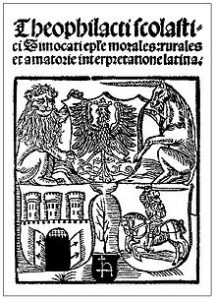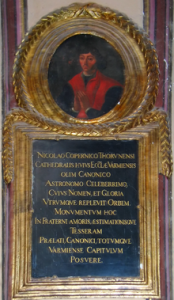Nicolaus Copernicus was a brilliant Polish physician, mathematician, theologian, and astronomer during the Renaissance. The scientist developed and supported a new, heliocentric explanation of the world order, rejecting the traditional Greek notion that the planets and the Sun circle around the Earth.

Nicolaus Copernicus was the fourth child born to German Barbara Watzenrode and Krakow-born merchant Nicolaus Copernicus. Since state borders and names have frequently changed over time, it is frequently unclear where the scientist was born and in which nation. It was on February 19, 1473, in the Prussian city of Thorn. The town is now known as Torun and is situated in what is now modern-day Poland.
Two of Nikolai’s older sisters married and moved out of the city, while the other became a nun. Andrzej, the elder brother, grew to be Nikolai’s devoted friend and ally. As a pair, they explored half of Europe while attending the top institutions.
The Copernici family had wealth and happiness for as long as their father was living. Tens of thousands of people died in Europe during the plague outbreak that started when Nicholas was nine years old. Copernicus Sr. succumbed to the dreadful illness as well, and his mother passed away in 1489, a few years later. The children were left as orphans and the family was left with no means of support. If Lukasz Watzenrode, a canon of the nearby diocese, hadn’t been Barbara’s uncle and brother, all would have ended horribly.
Luka was an educated man for those days, having earned a doctorate in canon law from the University of Bologna and a master’s degree from the Jagiellonian University in Krakow. He also held the title of bishop. Luka attempted to educate Nikolai and Andrzej while also tending to the children of his late sister.
Following Nikolai’s graduation from the local school in 1491, the brothers attended the Jagiellonian University’s Faculty of Arts in Krakow thanks to the financial support and patronage of their uncle. This incident signaled the start of a new chapter in Copernicus’ life and the first step toward further significant scientific and philosophical breakthroughs.
The Scientific
Following their graduation from Krakow University in 1496, the brothers Copernicus embarked on a voyage across Italy. Originally, they were going to ask their uncle, Bishop Emerland, for money to fund the trip, but he was broke. Luke proposed that his nephews become canons in his own diocese and fund their studies overseas with the salary they receive. Andrzej and Mikołaj were appointed canons in absentia in 1487, receiving a three-year study leave in addition to their salary in advance.
The brothers enrolled in the Bologna University to study canon law. Nicholas and Domenico Maria Novara, an astronomy teacher in Bologna, met by chance, and this encounter proved pivotal for the young Copernicus.
The future scientist made his first astronomical observation in 1497 with Novara. The conclusion that emerged was that, at both new and full moons, the distance to the moon was the same in quadrature. Copernicus initially began to question the veracity of Ptolemy’s theory, which held that all celestial bodies revolved around the Earth, in light of this observation.
Nicholas studied Greek and enjoyed painting in Bologna, in addition to reading books on astronomy, mathematics, and law. A painting purported to be a duplicate of Copernicus’s self-portrait has survived to this day.
After studying at Bologna for three years, the brothers left the university and returned to their homeland in Poland for a while. In the city of Frauenburg, where they worked, the Copernici petitioned for a delay and a few more years to pursue their education. According to some historians, during this period Nicholas lived in Rome and spoke on mathematics to noble gentlemen from high society, and helped Pope Alexander VI Borgia grasp the rules of astronomy.
In 1502, the Copernicus brothers landed in Padua. At the University of Padua, Nicholas earned foundational knowledge and practical expertise in medicine, and at the University of Ferrara, he received a PhD in theology. As a result of such prolonged instruction, in 1506, Copernicus returned home as a well-rounded adult.
By the time of his return to Poland, Nikolai was already 33 years old, while his brother Andrzej was 42. At that time, this age was considered commonly accepted for acquiring university degrees and completing study.
Copernicus’s continuing action is associated with his standing as a canon. The great scientist managed to create a career as a churchman, while also undertaking scientific research. It was fortunate for him that his writings were published after his passing and that he only finished his works at the end of his life.
Thankfully, Copernicus was spared from church punishment for his radical beliefs and teachings regarding the heliocentric system—something that Giordano Bruno and Galileo Galilei, his successors and followers, were unable to accomplish. Following his demise, Nicolaus Copernicus’s principal theories—which were documented in his book “On the Revolutions of the Celestial Spheres”—were freely disseminated throughout Europe and beyond. Only in 1616 was this theory declared heresy and banned by the Catholic Church.
System Heliocentric
Nicolaus Copernicus was among the first to recognize the flaws in the Ptolemaic model of the universe, which held that the Earth revolves around the Sun and other planets. With the use of crude, partially home-made astronomy instruments, the scientist was able to develop and validate the heliocentric solar system theory.
Simultaneously, Copernicus maintained until the end of his life that the stars and other distant luminaries that are visible from Earth are fixed on a unique sphere that encircles our planet. Because there was not even the most basic telescope available in Renaissance Europe, this misperception was brought about by the limitations of the technological capabilities of the era. Certain aspects of Copernicus’ theory—which followed the views of classical Greek astronomers—were later removed and improved upon by Johannes Kepler.
The culmination of thirty years of labor, the scientist’s major contribution was published in 1543 with the help of Rheticus, Copernicus’s favorite pupil. On the eve of his death, the astronomer himself had the good fortune to hold the published book in his hands.
There were six sections to the piece that was dedicated to Pope Paul III. The sphericity of the Earth and the universe was covered in the first section, and the principles of spherical astronomy and the formulas for determining the positions of stars and planets in the sky were covered in the second. The nature of the equinoxes is covered in the third section of the book, followed by the Moon, all planets, and the reasons of variations in latitude in the fourth, fifth, and sixth sections.
Astronomy and the science of the cosmos both benefited greatly from Copernicus’s teachings.
Individual life
Nicholas served as a canon in Frombork from 1506 to 1512, when his uncle was alive. He later rose to the position of adviser to the bishop and chancellor of the diocese. Bishop Luke passed away, and Nicholas moved to Fraenburg to serve as a canon in the local cathedral. Meanwhile, his brother, who had contracted leprosy, left the nation.
In 1516, Copernicus earned the office of chancellor of the Warmia diocese and relocated to the city of Olsztyn for four years. Here, the scientist got caught in the conflict that Prussia waged against the Teutonic Knights. The churchman proved himself to be a surprisingly good military planner, managing to assure the right defense and security of the castle, which resisted the onslaught of the Teutons.
Copernicus returned to Frombrock in 1521. He practiced medicine and was recognized as a great healer. Some stories claim that Nicolaus Copernicus improved the lives of numerous patients, primarily his fellow canons, by curing their illnesses.
In 1528, in his declining years, the astronomer fell in love for the first time. The scientist’s chosen one was a young girl named Anna, the daughter of Copernicus’ friend, the metal cutter Matz Schilling. They met in the scientist’s hometown, Torun. Copernicus brought Anna into his household as a domestic and distant relative because it was against Catholic clergy law to marry or have a romantic involvement with a woman.
But shortly, the new bishop made it plain to his subordinate that the church did not approve of this situation, thus the girl was forced to leave both the scientist’s home and the city.
Demise
The Wittenberg publication of Copernicus’ “On the Sides and Angles of Triangles, Both Plane and Spherical” dates back to 1542. A year later, the major piece was released in Nuremberg. The first printed copy of “On the Revolutions of the Celestial Spheres” was brought to the scientist by his friends and students as he was about to pass away.

On May 24, 1543, the renowned mathematician and astronomer passed away in the company of his loved ones at his Frombork residence.
The posthumous fame of Copernicus is commensurate with the scientific accomplishments and merits of the man. The astronomer’s visage is well-known to schoolchildren worldwide thanks to pictures and photographs; he is also honored with a university in Poland called Nicolaus Copernicus and monuments in other cities and nations.
